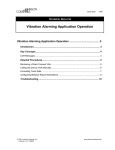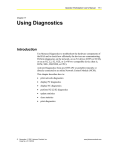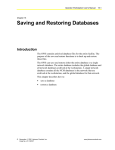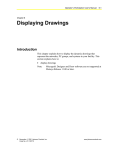Download M3 Workstation System Overview
Transcript
FAN 1153, 1153.2 Technical Section Issue Date 0101 TECHNICAL BULLETIN M3 Workstation System Overview M3 Workstation System Overview ......................................................3 Introduction........................................................................................................*3 Key Concepts...................................................................................................... 4 Related Information ....................................................................................................... *4 M3 Workstation Overview .............................................................................................. *4 Summary of Features .................................................................................................... *7 Configurations ................................................................................................................ 8 Software Architecture ................................................................................................... 10 * Indicates those sections where changes have occurred since the last printing. © 2001 Johnson Controls, Inc. Code No. LIT-1153050 www.johnsoncontrols.com 2 Technical M3 Workstation System Overview 3 M3 Workstation System Overview Introduction The M3 Workstation provides a Windows 98 Second Edition (SE) and Windows NT monitoring and command system for communication with supervisory control networks. Communication to the control networks is via local area network, direct serial connection, or multi-site dialup. The supervisory controllers compatible with M3 Workstation Release 3.0 or later include Metasys Companion/Facilitator panels Release 6.03 or later or the N30/N31 Supervisory Controllers Release 2.0 or later. This document describes: • related information • M3 Workstation overview • summary of features • configurations • software architecture 4 Technical Key Concepts Related Information As a reference, Table 1 lists the location of literature related to the M3 Workstation. Table 1: Related Information Manual FAN M3 Workstation Sales Resource Manual 642.0 M-Series Workstation Sales Resource Manual 641 M-Series Workstation with Companion/Facilitator Manual 1153.1 M-Series Workstation Manual 1153.2 N30 Supervisory Controller System Communications Manual 689.3 N30 Supervisory Controller User’s Manual 689.2 N30 Supervisory Controller Technical Manual 689.1 Metasys Companion Technical Manual 628.1 Facilitator FMS Technical Manual 1628.1 M-Alarm User’s Guide 1153.2 (LIT-1153750) M-Graphics User’s Manual 644.0 M-Trend User’s Manual 645.0 M-Historian Technical Manual 646.0 M-Applications Manual 653 M3 Workstation Overview The M3 Workstation represents a set of software components installed on the same machine and used in conjunction with one another to manage facility operations. The M3 Human-Computer Interface (HCI) application organizes the included software components, allows navigation between the components, and orchestrates their interactions. The M3 HCI is the central point for user login, initiating Site connections (for remote applications), and selecting between software applications. These applications are used to view and manipulate the online data at the sites and the historical site data archived on the workstation. The M3 HCI also reports alarms from the sites and allows their acknowledgement. The M3 Workstation may be extended by the end user to provide quick access to additional tools via a configurable menu. M3 Workstation System Overview One of the unique features of the M3 Workstation is its ability to manage or contain a number of other applications within an encompassing shell application. The M3 Workstation represents the included feature applications using a tabbed, or workspace, presentation style. These workspaces represent active documents that may be used standalone, as well as in the M3 Workstation container. As each workspace is selected, the M3 Workstation main menu changes appropriately to include the menus from the contained application. Figure 1: M3 Workstation 5 6 Technical The following component applications are tested and qualified as M3 Workstation workspaces: • Johnson Controls M-Trend Display (Release 2.0) • Johnson Controls M-Graphics Display (Release 4.0) • Johnson Controls M-Explorer Document (Release 2.0) • Johnson Controls Terminal Document (Release 2.0, Companion/Facilitator only) • M-Alarm container, includes M-Alarm Current Events Viewer (Release 1.0) and Alarm Panel • Johnson Controls Data Visualization Applications (Release 1.1), Comfort Chart, Starfield, Analog Profile • Johnson Controls Metasys Historical Data Visualization Applications (Release 1.0), River of Time, Data VCR, Metasys System Analysis Tool, Color Spectrum M3 Human Computer Interface* M-Graphics* Terminal M-Collector Alarm Management M-Explorer/ M-Inspector BACnet Scheduling Controls M-Trend M-Password Companion/Facilitator OPC Data Access Server N30/BACnet OPC Data Access Server* Historian Database* * Protected by software license (M-Authorize) Application overview Figure 2: M3 Workstation Software Applications Overview Other applications may work, but are not tested or officially supported. The list of available feature applications displays when the M3 Tools > Add option is selected. The application list only includes the applications installed and registered on the computer. M3 Workstation System Overview 7 Summary of Features The following is a brief list of M3 Workstation features: • Windows 98 SE and Windows NT compatibility Note: The M3 Workstation software uses standard Microsoft Windows installation and operating characteristics. For this reason, the M3 Workstation should run on the most recent versions of the supported operating systems. Install the most recent service packs. The minimum, qualified service pack levels are listed in the Installing the M3 Workstation Technical Bulletin (LIT-1153100). • Remote access to multiple sites. The ability to support multiple concurrent site connections is dependent on the capabilities of the OLE for Process Control (OPC) Data Access servers. For example, two N30 sites and one Companion/Facilitator site can be connected simultaneously. • dial-in alarms from the controller networks (Windows NT only from N30 sites) • alarm management workspace (includes M-Alarm Current Events Viewer and Alarm Panel) • user access system (M-Password) • trend collection into a historian database (M-Collector) • dynamic graphics with animation capabilities (M-Graphics) • graphical viewing of archived trend data (M-Trend) • online object explorer (M-Explorer) • online object inspector (M-Inspector, N30s only) • VT100 Terminal Interface to currently connected Companion/Facilitator Sites • graphical scheduling for N30 sites 8 Technical Configurations Figure 3 shows an example of a Building Automation System (BAS) with M3 Workstations and Companion/Facilitator Panel units. M3 Workstation Modem Companion/Facilitator Panel Unit Modem is inside enclosure. Companion/Facilitator Panel Unit Modem is inside enclosure. Printer M3 Workstation RS-232 N2 Bus N2 Bus DX 9100 DX 9100 UNT Unitary (UNT) Controller Air Handling Unit (AHU) Panel unit Figure 3: BAS with M3 Workstation and Companion/Facilitator Panel Units 9 M3 Workstation System Overview Figure 4 shows an example of a BAS with M3 Workstations and N30 controllers. Modem M3 Workstation M3 Workstation BACnet IP/Ethernet RS-232 N30 Modem N30 M3 Workstation N2 Bus N2 Bus UNT DX Variable Air Volume Modular Assembly (VMA) VMA DX UNT Peer to peer Figure 4: BAS with M3 Workstation and N30 Supervisory Controllers 10 Technical Modem N30 N30 M3 Workstation Modem Companion/Facilitator Panel Unit N30 N30 Mixed fms Figure 5: FMS with M3 Workstation, Companion/Facilitator Panel Units, and N30 Supervisory Controllers Note: Two N30 sites and one Companion/Facilitator site can be connected simultaneously. Software Architecture With the introduction of the M3 Workstation, the latest technology is used in the architecture. To assist in understanding this technology, a brief explanation of terms is provided. OLE Object Linking and Embedding (OLE) allows users to create and edit documents containing items or objects created by multiple applications. ActiveX ActiveX is an extension of Microsoft OLE technologies. It not only includes OLE controls, it adds a series of Internet and multimedia services to create feature-rich applications. Workspace The M3 Workstation organizes software components using a tabbed, or workspace, presentation style. These workspaces represent Active Document applications, which may be used standalone as well as in the M3 Workstation. Refer to the Using Workspaces chapter in the M3 Workstation User’s Guide (LIT-1153200). M3 Workstation System Overview 11 OPC Server OLE for Process Control (OPC) is a specification for applying OLE in the process control industry. Its goal is to provide standard methods to integrate (share/exchange) system data with other business systems. OPC servers are the key component. They control the interaction and communication between a client requesting information and the physical data provider (hardware and/or software). For example, the M3 Workstation applications (clients) communicate with OPC servers resident on the Personal Computer (PC) that communicates with the Companion/Facilitator or N30 Supervisory Controller. ODBC Online Database Connectivity (ODBC) provides an interface to allow M-Trend to make a standard set of requests for data regardless of the actual database package used. For example, in an M3 Workstation, historical data is defined in the format used by Microsoft Access. Using ODBC, M-Trend can view data stored in this database even though it has no knowledge of the Access database format. Data Source Name (DSN) A DSN file is used to define a connection to an archived database for M-Trend to access. When defining an ODBC data source for M-Trend, you are actually naming a connection, or map, to the M-Historian database. 12 Technical Notes Controls Group 507 E. Michigan Street P.O. Box 423 Milwaukee, WI 53201 www.johnsoncontrols.com Printed in U.S.A.



















